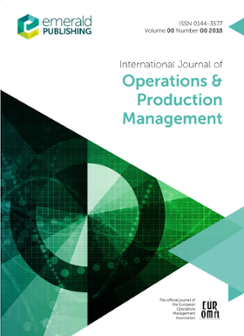Practitioners' learning about healthcare supply chain management in the COVID-19 pandemic: a public procurement perspective
IF 7.4
2区 管理学
Q1 MANAGEMENT
International Journal of Operations & Production Management
Pub Date : 2021-12-09
DOI:10.1108/ijopm-05-2021-0348
引用次数: 22
Abstract
PurposeThe procurement and supply of crucial healthcare products in the early stages of the COVID-19 emergency were chaotic. To prepare for future crises, we must be able to describe what went wrong, and why, and map out ways to build agility and resilience. How can this be done effectively, given the highly complex and diverse network of actors across governments, care providers and supply chains, and the extreme uncertainty and dynamism in the procurement system and supplier markets? The purpose of this study was to capture learning from practitioners in “real time” in a way that could frame and inform capacity building across healthcare systems with varying procurement and supply management maturity.Design/methodology/approachThis exploratory study involved interviews with 58 senior public procurement practitioners in central and regional governments, NGOs and leaders of professional organizations from 23 countries, very early in the COVID crisis. Following the first, inductive phase of analysis leading to five descriptive dimensions, the awareness-motivation-capability (A-M-C) framework was applied in a further round of coding, to understand immediate challenges faced by procurement practitioners, how the complex, multi-level procurement system that shaped their motivations to respond and critical capabilities required to face these challenges.FindingsDevelopments across 23 countries and practitioners' learning about procurement and supply in the pandemic crisis can be captured in five overarching themes: governance and organization, knowledge and skills, information systems, regulation and supply base issues. Together these themes cover the strengths and gaps in procurement and supply capability encountered by procurement leaders and front-line personnel. They highlight the various facets of structure, resource and process which constitute organizational capability. However, to account better for the highly dynamic situation characterized by both unprecedented rivalry and cooperation, analysts must also pay attention to actors' emerging awareness of the situation and their rapidly changing motivations.Originality/valueThe application of the A-M-C framework is unique in the healthcare supply chain and disaster management literature. It enables a comprehensive overview of healthcare procurement from a system perspective. This study shows how increasing system preparedness for future emergencies depends both on developing critical capabilities and understanding how awareness and motivation influence the effective deployment of those capabilities.2019冠状病毒病疫情下从业人员对医疗供应链管理的学习:公共采购视角
目的在新冠肺炎紧急情况的早期阶段,关键医疗产品的采购和供应混乱。为了为未来的危机做好准备,我们必须能够描述出了什么问题,为什么出了问题,并制定出建立灵活性和韧性的方法。考虑到政府、护理提供者和供应链中的参与者网络高度复杂和多样化,以及采购系统和供应商市场的极端不确定性和活力,如何有效地做到这一点?这项研究的目的是“实时”捕捉从业者的学习,以确定不同采购和供应管理成熟度的医疗保健系统的能力建设并为其提供信息。设计/方法/方法这项探索性研究在新冠肺炎危机早期采访了来自23个国家的58名中央和地区政府、非政府组织和专业组织的高级公共采购从业者。在导致五个描述性维度的第一个归纳分析阶段之后,在下一轮编码中应用了意识-动机-能力(A-M-C)框架,以了解采购从业者面临的直接挑战,多层次的采购系统,塑造了他们应对这些挑战的动机和关键能力。发现23个国家的发展以及从业人员在疫情危机中对采购和供应的了解可以分为五个总体主题:治理和组织、知识和技能、信息系统、监管和供应基础问题。这些主题涵盖了采购领导人和一线人员在采购和供应能力方面遇到的优势和差距。它们强调了构成组织能力的结构、资源和过程的各个方面。然而,为了更好地解释以前所未有的竞争和合作为特征的高度动态的局势,分析人士还必须关注行为者对局势的新认识及其迅速变化的动机。独创性/价值A-M-C框架在医疗供应链和灾害管理文献中的应用是独特的。它能够从系统的角度对医疗采购进行全面的概述。这项研究表明,加强系统对未来紧急情况的准备,既取决于关键能力的发展,也取决于了解意识和动机如何影响这些能力的有效部署。
本文章由计算机程序翻译,如有差异,请以英文原文为准。
求助全文
约1分钟内获得全文
求助全文
来源期刊
CiteScore
13.30
自引率
17.20%
发文量
96
期刊介绍:
The mission of the International Journal of Operations & Production Management (IJOPM) is to publish cutting-edge, innovative research with the potential to significantly advance the field of Operations and Supply Chain Management, both in theory and practice. Drawing on experiences from manufacturing and service sectors, in both private and public contexts, the journal has earned widespread respect in this complex and increasingly vital area of business management.
Methodologically, IJOPM encompasses a broad spectrum of empirically-based inquiry using suitable research frameworks, as long as they offer generic insights of substantial value to operations and supply chain management. While the journal does not categorically exclude specific empirical methodologies, it does not accept purely mathematical modeling pieces. Regardless of the chosen mode of inquiry or methods employed, the key criteria are appropriateness of methodology, clarity in the study's execution, and rigor in the application of methods. It's important to note that any contribution should explicitly contribute to theory. The journal actively encourages the use of mixed methods where appropriate and valuable for generating research insights.

 求助内容:
求助内容: 应助结果提醒方式:
应助结果提醒方式:


